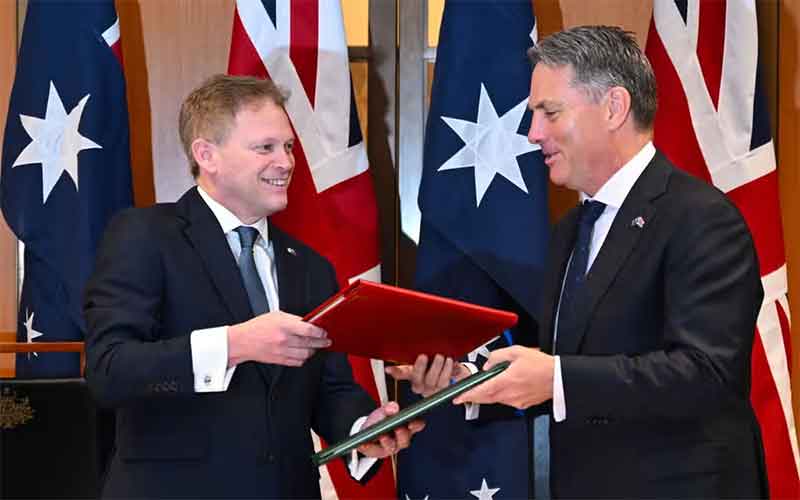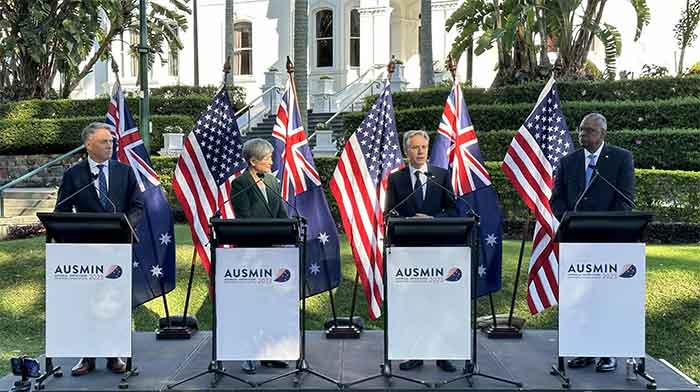
The skin toasted Australian Minister of Defence, Richard Marles, who resembles, with each day, the product of an overly worked solarium, was adamant. Not only will Australians be paying a bill up to and above A$368 billion for nuclear powered submarines it does not need; it will also be throwing A$100 billion into the coffers of the military industrial complex over the next decade to combat a needlessly inflated enemy. Forget diplomacy and funding the cause (and course) of peace – it’s all about the weapons and the Yellow Peril, baby.
On April 18, Marles and Defence Industry Pat Conroy barraged the press with announcements that the defence budget would be bulked by A$50.3 billion by 2034, with a A$330 billion plan for weapons and equipment known as the Integrated Investment Program. The measures were intended to satisfy the findings of the Defence Strategic Review. “This is a significant lift compared to the $270 billion allocated for the 10-year period to 2029-30 as part of the 2020 Defence Strategic Update and 2020 Force Structure Plan,” crowed a statement from the Defence Department.
Such statements are often weighed down by jargon and buoyed by delusion. The press were not left disappointed by the insufferable fluff. Australia will gain “an enhanced lethality surface fleet and conventionally-armed, nuclear-powered submarines”, an army with “littoral manoeuvre” capabilities “with a long-range land and maritime strike capability”, an air force capable of delivering “long-range intelligence, surveillance and reconnaissance” with “an enhanced maritime, land and air-strike capability” and “a strengthened and integrated space and cyber capability”. The glaring omission here is the proviso that all such policies are being essentially steered by Washington’s defence interests, with Canberra very much the obedient servant.
The defence minister was firmly of the view that all this was taking place with some speed. “We are acting very quickly in relation to [challenges],” Marles insists. “I mean, the acquiring of a general-purpose frigate going forward, for example, will be the most rapid acquisition of a platform that size that we’ve seen in decades.” Anyone who uses the term “rapid” in a sentence on military acquisition is clearly a certified novice.
The ministers, along with the department interests they represent, are certainly fond of their expensive toys. They are seeking a fourth squadron of F-35 Joint Strike Fighters as replacements for the F/A-18 Super Hornets. The EA-18G Growler jets are also being replaced. (That said, both sets of current fighters will see aging service till 2040.) Three vessels will be purchased to advance undersea war capabilities, including the undersea drone prototype, the Ghost Shark.
The latter hopes to equip the Royal Australian Navy “with a stealthy, long-range autonomous undersea warfare capability that can conduct persistent intelligence, surveillance, reconnaissance and strike.” Importantly, such acquisitions and developments are always qualified by how well they will work in tandem with the imperial power in question. The media release from the Department of Defence prefers a more weasel-worded formula. The Ghost Shark, for instance, “will also enhance Navy’s ability to operate with allies and partners.”
The new militarisation strategy is also designed to improve levels of recruitment. Personnel have been putting down their weapons in favour of other forms of employment, while recruitment numbers are falling, much to the consternation of the pro-war lobby. A suggested answer: recruit non-Australian nationals. This far from brilliant notion will, Marles suggests, take some years. But a good place to start would be the hundreds of thousands of New Zealanders resident in Australia. Sheer genius.
The announcement was also meant to offer budget trimmers a barely visible olive branch, promising “to divest, delay or re-scope projects that do not meet our strategic circumstances.” (They could start with the submarines.) A$5 billion, for instance, will be saved from terminating naval transport and replenishment ships intended to refuel and resupply war vessels at sea.
Hardly appropriate, opined some military pundits keen to keep plucking the money tree. Jennifer Parker of the National Security College suggested that, “The removal of the Joint Support ship means there is no future plan to expand Australia’s limited replenishment capability of two ships – which will in turn limit the force projection capability and reach of the expanded surface combatant fleet if the issue is not addressed.”
The focus, as ever, is on Wicked Oriental Authoritarianism which is very much in keeping with the traditional Australian fear of slanty-eyed devils moving in on the spoils and playground of the Anglosphere. Former RAAF officer and executive director of the Air Power Institute, Chris McInnes, barks in aeronautical terms that Australia’s air power capability risks being “put in a holding pattern for the next 10 years.” Despotic China, however, was facing no such prospects. “There is a risk of putting everything on hold. The People’s Liberal Army is not on hold. They are going to keep progressing their aircraft.” (The air force seems to do wonders for one’s grammar.)
China’s Foreign Ministry spokesman Lin Jian was cool in his response to the latest promises of indulgent military spending Down Under. “We hope Australia will correctly view China’s development and strategic intentions, abandon the Cold War mentality, do more things to keep the region peaceful and stable and stop buzzing about China.” No harm in hoping.
Dr. Binoy Kampmark was a Commonwealth Scholar at Selwyn College, Cambridge. He currently lectures at RMIT University. Email: [email protected]












































